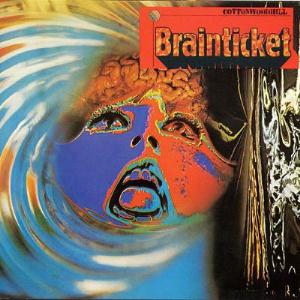Cottonwoodhill (1971) is the remarkable debut album from Brainticket. This classic cult album was far ahead of its time. It combines elements of rock, psychedelic music and funk with African rhythms and the use of acoustic and ethnic instruments like flutes, tabla and sitar. Moreover, the album contains an extensive use of soundscapes, like the siren of a police car, the screaming of a monkey and Beethoven's 5th symphony, long before this became more common in the age of digital samplers. Furthermore Cottonwoodhill contains the dominant sound of a Hammond organ played repetitively and with the precision of a computer by Joël Vandroogenbroeck, and finally the vocals by Dawn Muir. She doesn't sing, but she first whispers seductively and then she screams hysterically, shouts euphorically and cries anxiously, so one can't make much sense of the lyrics. All these elements are added up into some orchestrated madness. The story of Brainticket is remarkable as well. Vandroogenbroeck was a Belgian classical educated pianist, but later on he switched to jazz. As a jazz pianist he toured through Europe, but also in Congo where he was inspired by African music, which he also incorporated in his music. In 1962 he moved to Switzerland where he met guitarist Ron Bryer. They shared a passion for the music of Jimi Hendrix, The Beatles and King Crimson. Together with percussionist Wolfgang Paap they formed a band named Third Eclipse. They played a few gigs, but these weren't well-received by the conservative Swiss audience. However, they were contacted by a new record label and so they went into the studio together with drummer Cosmo Lampis, bassist Werner Fröhlich from a band called The Toad, studio technician Hillmuth Klobe, who added generators and sound effects, and singer Dawn Muir. They renamed the band to Brainticket and then recorded what would become the album Cottonwoodhill. All of them were dealing with personal issues and somehow this was all channelled into the music so the band grew spiritually as well as musically. The album is the product of a group of individuals who were at the right place and time to create something magical. As I said before: being ahead of its time the album wasn't well-received. Especially not in Switzerland because the record company came up with the idea of putting some warnings on the record as a form of publicity, like: 'after listening to this disc, your friends won't know you anymore' and 'only listen once a day to this disc, your brains might be destroyed.' It caused the band to be labelled as LSD junkies and as a result the album was banned in many countries. Vandroogenbroeck had to make a living by selling gasoline in a gas station. Luckily the album was received better in Germany having an underground scene with bands like Can, Faust, Amon Düül and the early Kraftwerk and Tangerine Dream. What Brainticket had in common with those bands is that they dropped all conventions and just followed the flow of the music. The tragic death of Ron Bryer was the end of the first line-up of Brainticket. Vandroogenbroeck moved to Italy where he met Carole Muriel. With her and a few Italian musicians he formed a new line-up to record Psychonaut (1972, see review) and Celestial Ocean (1973, see review). Both albums contained a different style of music, but they are both essential in their own right. Psychonaut is much more in the direction of prog rock, while with Celestial Ocean Vandroogenbroeck started to work with the MiniMoog synthesizer. It's a concept album dealing with the religion of the ancient Egyptians. After a silence of seven years a new line-up recorded two electronic ambient albums in Switzerland: Adventure (1980) and Voyage (1982). After another long hiatus of twenty years Vandrooghenbroeck and Muriel, then living in the United States, returned with their latest studio album to date Alchemic Universe (2002). Finally in 2012 some musicians joined Vandroogenbroeck to do a short tour in the US. Six albums in forty years aren't that much, but it contributed to their cult status. Cottonwoodhill has been reissued several times, but this one is the first in the US. As I said before the album was banned because it was considered to promote the use of LSD. It's a straight re-release; no bonus tracks were added and the original artwork was used for the cover. The recordings have only been remastered. Its rerelease coincides with the tour to introduce the band to a new audience. Cottonwoodhill still sounds very fresh in 2013. While listening to it now I noticed that it doesn't sound like anything else that was recorded at the time. It's much more related to the psychedelic music from the nineties, a cross-over between styles blending acid rock with African rhythms and a bit of funk and even some elements of techno. If you try to understand the music you'll probably hate it, but if you go with the flow and let the weirdness come over you, then you might be captured by its beauty. Maybe this won't happen during the first listen, but after a few spins you'll probably experience it. Cottonwoodhill isn't so much an LSD trip, but more a spiritual trip to your own self. It may be disturbing, but that's the only way to get you out of your comfort zone in order to experience something new. ***** Erik Gibbels (edited by Peter Willemsen) Where to buy? |
